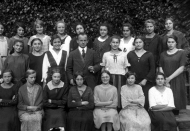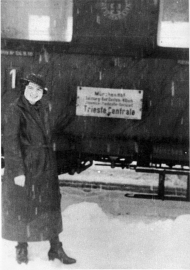|
|
|
|
|
|
|
|
|
|
|
|
|
|
|
|
|
|
|
|
|
|
|
|
|
|
|
||||||||||||||||
|
|
Elisabeth Veith Born: 1911 in Augsburg. Father’s occupation: wholesaler. Domicile: 8 Prinzregentenstraße. Companies: 38 Jakoberstraße. Elisabeth’s father, Hugo Veith (b. 1883 in Augsburg), was a co-partner of the company “Sigmund Veith & Co., Därme und Gewürze en gros” (“Wholesale intestines and spices”), as well as of the wholesale company of grain “Franz Schwarz”. His partner, Franz Schwarz, was the father of Ilse Schwarz. Hugo’s wife was called Anneliese (“Liesl”), née Levi (b. 1887 in Cannstatt). Like Elisabeth, her sisters Margot and Marianne also attended Maria-Theresia-School. Elisabeth attended Maria-Theresia-School from 1924 to 1928 in classes 3–6; presumably, she had joined the school in 1922 in class 1. In 1936, Elisabeth married Manfred Ackermann (b. 1909 in Aidhausen). The couple emigrated to Binyamina, Palestine, that same year. They had two children. Elisabeth’s husband died in Binyamina, Israel, in 1984. Elisabeth Ackermann, née Veith, also died in Binyamina in 1987. Elisabeth’s father, who was released from the concentration camp Dachau in 1940 because he had an immigration permit for the USA, was able to emigrate with his wife, via Lisbon, to the USA just in time. After the war, the couple moved to Binyamina, where Hugo died in 1967, his wife, Anneliese, in 1981 or 1982. Elisabeth’s brother, Helmuth (1915–99), emigrated to the USA in 1937. |
|
|
Margot Veith Born: 1910 in Augsburg. Father’s occupaton: wholesaler. Domicile: 8 Prinzregentenstraße. Companies: 38 Jakoberstraße. Margot’s father, Hugo Veith (b. 1883 in Augsburg), was a co-partner of the company “Sigmund Veith & Co., Därme und Gewürze en gros” (“Wholesale intestines and spice”), as well as of the wholesale company of grain “ Franz Schwarz”. His partner, Franz Schwarz, was the father of Ilse Schwarz. Hugo’s wife was called Anneliese (“Liesl”), née Levi (b. 1887 in Cannstatt). Like Margot, her sisters Marianne and Elisabeth also attended Maria-Theresia-School. Margot attended Maria-Theresia-School from 1924 to 1926 in classes 5 and 6; presumably, she had joined the school in 1920 in class 1. In May 1925, Margot celebrated her “confirmation” in Augsburg, together with nine other Jewish girls (Bat Mitzvah: the feast of religious maturity for Jewish girls; it can be celebrated individually on the Sabbath after a girl’s 12th birthday, but in Augsburg it was held annually or even after longer intervals for several age groups together, similar to the Protestant confirmation). After completing school, Margot ran a small kindergarten at a garden site and in a room of her parents’ house, where she looked after Jewish and non-Jewish children. In 1932, she married Leo Heilbrunn (b. 1905 in Gotha) and henceforth lived with him in Gotha. The couple had two sons. Gertrud Dann, the sister of Elisabeth and Lotte Dann, kept running the kindergarten in Augsburg. In 1934, the kindergarten had to move to a side room of the synagogue, and Gertrud was not allowed to teach non-Jewish children any more. In 1938, the Heilbrunn family emigrated to Palestine. They lived in Kfar Yedidya. In 1940, they accomodated 14-year-old Arie Weil, the brother of Gertrud and |
|
|
|
Marianne Veith Born: 1913 in Augsburg. Father’s occupation: wholesaler. Domicile: 8 Prinzregentenstraße. Companies: 38 Jakoberstraße. Marianne’s father, Hugo Veith (b. 1883 in Augsburg), was a co-partner of the company “Sigmund Veith & Co., Därme und Gewürze en gros” (“Wholesale intestines and spice”), as well as of the wholesale company of grain “Franz Schwarz”. His partner, Franz Schwarz, was the father of Ilse Schwarz. Hugo’s wife was called Anneliese (“Liesl”), née Levi (b. 1887 in Cannstatt). Like Marianne, her sisters Elisabeth and Margot also attended Maria-Theresia-School. Marianne attended Maria-Theresia-School from 1924 to 1929 in classes 2–6; presumably, she had joined the school in 1923 in class 1. At the same time, she already was an apprentice at her father’s company. On May 25, 1928, Marianne celebrated her “confirmation” in Augsburg, together with three other Jewish girls (Bat Mitzvah: the feast of religious maturity for Jewish girls; it can be celebrated individually on the Sabbath after a girl’s 12th birthday, but in Augsburg it was held annually or even after longer intervals for several age groups together, siilar to the Protestant confirmation). In 1935, Marianne emigrated to Palestine in order to marry Martin Einstein (b. 1904), a cousin of Beate, Brunhilde and Liese Einstein. The couple lived in Binyamina. They had three daughters. Martin worked as a farmer and was an employee of a dairy. He died in 1972. Marianne Einstein, née Veith, died in Haifa, Israel, in 2000. Marianne’s father, who was released from the concentration camp Dachau in 1940 because he had an immigration permit for the USA, was able to emigrate with |
|
Leonie Vogel Born: 1892 in Augsburg. Father’s occupation: businessman. Leonie’s parents were Samuel Vogel (b. 1844) and Emilie, née Erdmann. Leonie attended the “Municipal School for Daughters” (“Städtische Töchterschule”), which later was to be called “Maria-Theresia-School”, from 1904 to 1907 in classes 1–3. In 1907, her father died in Augsburg. After her time at school, Leonie became an actress. Around 1917, she lived in Zurich, Switzerland, and around 1920 in Munich. There are entries for Leonie Vogel in the Yearbook of the German Theatres (“Deutsches Bühnen-Jahrbuch”) of the years 1919–30, covering the years 1918–29. For the years 1919, 1928 and 1929 her name is given without engagement. During the other years, she worked for the following theatres: Theatre of the City of Bern, Switzerland (1918), Theatres of the Bavarian State, Munich (1920), People’s Theatre at Bülowplatz, Berlin (1921–23), Theatre of Düsseldorf, Private Theatre Louise Dumont / Gustav Lindemann (1924–26), Theatre of the City of Oberhausen (1927). Leonie played only minor roles. Her personal file kept at the Theatre Museum of Düsseldorf says that she mastered well the roles of a crude and comical character. In the spring of 1928, the manager of the Theatre of the City of Constance made inquiries about her artistical and personal qualities as “the comic old woman”; Leonie was aged 35 at that time. In the season 1923/24, Leonie had an engagement at the People’s Theatre of Berlin. Among other plays, she appeared in Leonid N. Andreev’s King Hunger; the set was designed by Oskar Schlemmer from the Bauhaus. While working for the Berlin theatre, Leonie also appeared in productions of the director Jürgen Fehling. |
Sources: |

